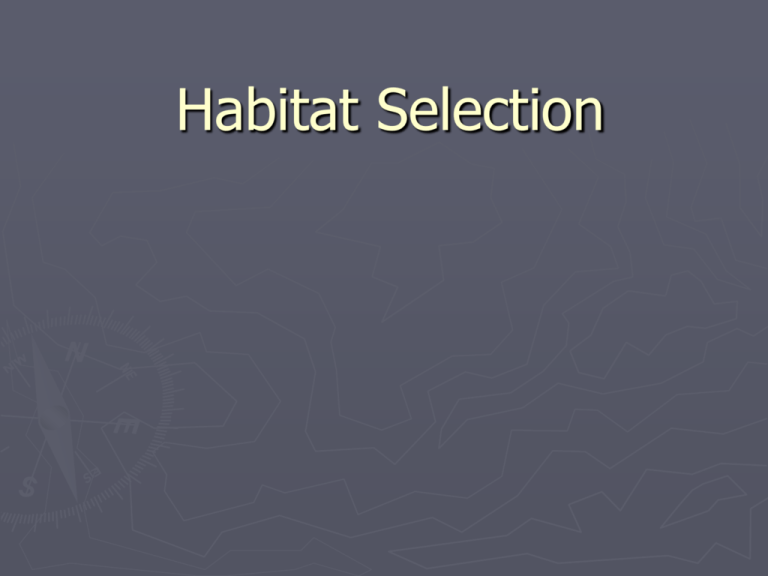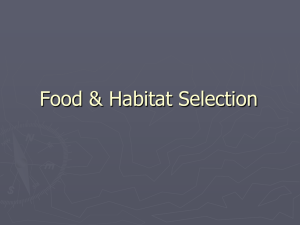Habitat Selection
advertisement

Habitat Selection Habitat Selection? Some Terms… ► Habitat – Place where an organism lives ► Home Range – Area that an organism occupies during its life ► Territory – An area occupied and defended by an organism ► Migration – The long distance movement, and subsequent return, from one location to another. Why choose a certain habitat? ► Why do you live where you do? Why do animals choose a certain habitat? ► Genetics vs. Early Experience Why do animals choose a certain habitat? ► Food ► Ideal Free Distribution (Manfred Milinski) Genetics and Early Experience 1) Males and Females raised on Cellulose or Cedar bedding 2) Males generally prefer what they are raised on. 3) Females generally prefer cedar by at least the third day. 4) Older females switch to cedar faster than younger females. 5) Males influenced by early experience whereas females are more influenced by genetics. How do animals pick a habitat: Genetics and Early Experience Factors: Early Experience Foraging Behavior ► Barn Owl ► What to eat? More on Patch Ecology ► Risk-Sensitive – Animals that can tell one patch from another patch Risk-Prone: Animals willing to take risk Risk-Averse: Animals not willing to take the risk Changes in the strategy: Are animals risky or safe? ► “Risk Prone” willing to take risks ► “Risk-averse” avoid risk and will take the safer option. Changes in the strategy: Caraco et. al. and YellowEyed Juncos ► Birds choose 1) variable (0 to 6 seeds) or 2) constant (3 seeds) ► Done at 1°C and 19°C. ► Birds are risk-averse at 19°C, risk-prone at 1°C. Risk-Averse animals will go here 1st hour Risk-Prone animals will go here 1st hour 2nd hour Patch #1 2nd hour Patch #2 Why do animals choose a certain habitat? ► Food ► Food and the Ideal Free Distribution (Manfred Milinski) Why do animals choose a certain habitat? ► Your tax dollars (or mine) at work! ► Competitive Unit Model Territories ► An area actively defended by an animal ► Why Defend? ► Anolis ► Not Food! ► Temperature and Predator Avoidance Territories ► Anolis lizard arrive quicker on experimental plots and use the site more. ► Lizards LEARN where good habitats are by watching others. Territories - Conditional Pied Wagtail ► Eats insects washing on shore. ► Lots of food, allows Satellites (help defend territory….have less knowledge of food pattern) ► Byproduct Mutualism in under certain circumstances ► Territories - Changing Side-Blotched Lizard 1) Defend Rocky Territories 2) Less Rocks, larger territories 3) More Rocks, smaller territories more competition. 4) Average 1 female in both Territories – Defend for Mating ► Some animals might defend territories for mating purpose ► Antlered flies – defend territories on rotten logs Migration ► When territories or habitats change drastically over time, what do you do? ► Migration – Long distance movement and subsequent return from one location to another. How do you know where to go? Different animals have different abilities to tell where they are: ► Piloting – Recognizing landmarks ► Compass Orientation – Able to tell specific directions ► How do you know where to go? ► Various Sensory Abilities: Visual Cues Stars Magnetism Migration – Using the Sun ► Raised in captivity and then released: ► b) first 5 minutes of autumn migration ► a) Clock shifted butterflies fly west ► c) Natural population fly south Migration – Using Earth’s Magnetic Field Green Sea Turtles Green Sea Turtles Migration – Using Stars ► Emlen funnel (add to words) ► Ink on feet mark footprints. ► Left (spring), Middle (fall) Right (when night sky is obscured. Factors Effecting Migration Some populations migrate, others do not. ► Leapfrog effect ► A does not leave. ► Further north, the further south they travel. ► Why? ► Might miss food, might not return quick enough for breeding territory. ► Factors effecting migration ► Sometimes migrates ► Older, more dominate males migrate less. ► Juveniles make the best of what they can, migrate until larger? ► Researchers not quite sure. Factors effecting migration 1) Birds with low fat reserves (A) 2) Birds with high fat reserves (B) Habitat Selection in Pill Bugs Types of Movements: Taxis: Directed movement towards/away from a stimulus Kinesis: Random movements Choice Chambers Thing to think about? ► What do they eat? ► What eats them?






